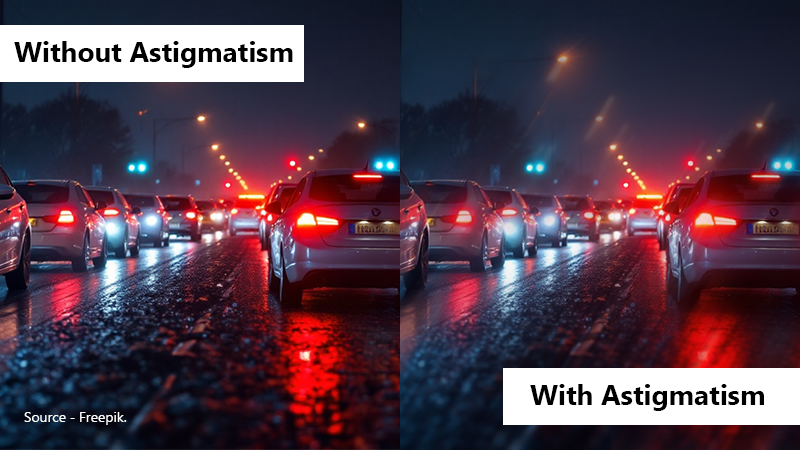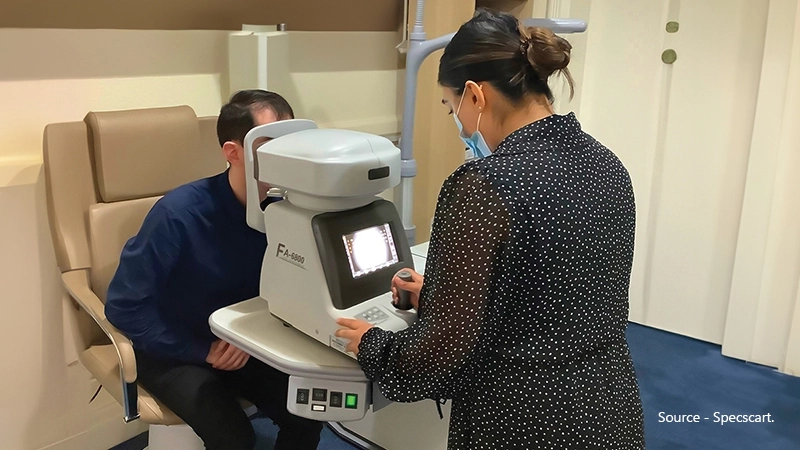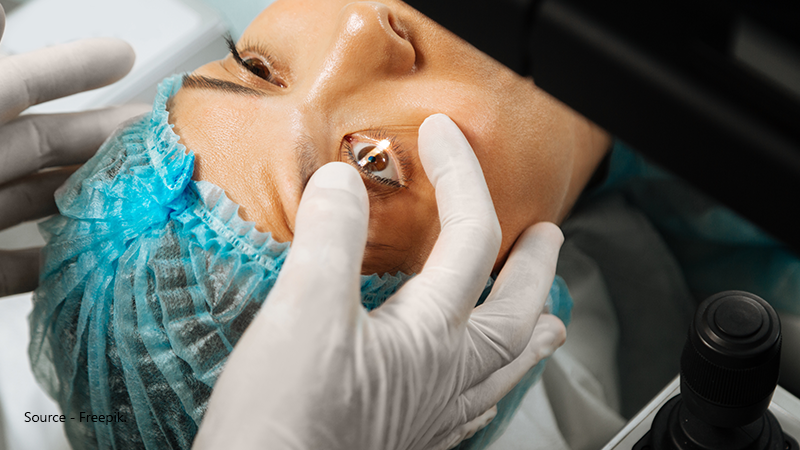Astigmatism is a common eye condition which occurs due to a refractive error caused by the retina of the eye. It affects 60% of the population in Europe itself. It is not a disease but a condition that causes blurry or distorted vision due to irregularly shaped cornea. Let’s take a look at everything you need to know about astigmatism.
What is astigmatism?
This is an eye condition which leads to blurred or distorted vision. In an astigmatic eye, the cornea has an irregular shape that often looks like a football. However, in a normal eye, the shape of the outermost part of the eye aka the cornea is mostly spherical.
As you all know, the cornea is solely responsible for focusing incoming light rays on the retinal wall. It further helps the retina to interpret and send the message via the optic nerve to form the real image. However, the astigmatic eye struggles to project light at a single point of the corneal wall, which causes it to scatter. The scattering of light gives us a distorted or blurred vision.
Astigmatism can also occur with other refractive error eye problems like nearsightedness (myopia) or farsightedness (hyperopia) at the same time.
What are astigmatism symptoms?

There are multiple symptoms that can tell if you have astigmatism. The most common symptom is blurry or distorted vision in certain areas while looking at an object. You might also deal with regular eye strain or headaches if you have astigmatic eyes. However, these symptoms can also be present in other refractive eye conditions as well. That’s why, you need to get a comprehensive eye test done to figure out the exact cause of these problems.
What causes astigmatism?
There can be various reasons that can contribute to this eye condition. However, as of now, there is no clarity on the exact reason for this condition. And, there are no ways to prevent it from happening either.
How to Diagnose Astigmatism?

As discussed above, the only way to diagnose astigmatism is by undergoing a comprehensive eye test. This test involves multiple devices and procedures that determine:
- Whether you have astigmatism
- The required refractive correction
- The angle of astigmatism
Here are some steps involved in your comprehensive eye test that can help in the diagnosis of astigmatism:
- Visual acuity test: You will be asked to read different letters or symbols on an eye chart from a certain distance. This test is designed to assess how clearly can you see and helps in detecting vision issues.
- Autorefractor test: The autorefractor test measures how light is focused when it enters your eyes. This device provides an estimate of your prescription.
- Phoropter test: The phoropter lens often works in combination with a visual acuity test. In this test, you are given different lens combinations to see which lens helps you see more clearly.
- Keratometer measurement: A keratometer test measures the curvature of your cornea and helps in determining the degree and orientation of astigmatism.
How can astigmatism be prevented?
Unfortunately, there is no way to prevent astigmatism from developing. It can be present in a child at the time of birth or like most cases may develop over time during adulthood or as you become older. The only thing you can do about astigmatism is correct it by using glasses, contact lenses, or getting eye surgery to correct the condition.
How to correct astigmatism?
Let’s take a look at the different ways mentioned above to correct astigmatism in detail.
Prescription Glasses

Wearing prescription glasses is one of the most common and practical ways to correct astigmatism. The best part is that it allows you to fix this eye condition and other refractive errors. The cylindrical power on your prescription is used to correct the condition while the axis degree which is between 0 to 180 indicates the direction of cylindrical power in the lenses to correct astigmatism.
Contact Lenses

You can also use contact lenses to correct astigmatism. It works pretty much the same way as prescription glasses other than the fact that it sits right on your eyes. Instead of normal contact lenses, people with astigmatism are suggested to use toric lenses. There are two kinds of toric lenses available in the market including toric soft lenses and rigid gas permeable lenses also known as RPG lenses. Toric soft lenses do the job for normal or mild astigmatism but RPG lenses do a better job in case of more complex cases.
Refractive Surgery

Another option to correct astigmatism is refractive surgery. You might have heard about refractive surgeries like LASIK, SMILE, or Astigmatic Keratotomy. They are helpful in correcting astigmatism by reshaping the cornea in a way that allows light to focus properly on the retina.
To sum it up
Astigmatism is a very common eye condition and around every 1 in 3 people around the world suffer from this condition. However, you can correct it simply with a pair of prescription glasses. Having regular eye exams will ensure that any eye condition can be detected at the earliest. You can schedule a free eye test at any of our stores in Manchester. You can also check out our wide range of premium eyewear collections available at 70% lower prices than the high street. The best part is that you also get free clear fully loaded lenses with anti-glare, anti-UV, anti-scratch, and impact-resistant coatings customised to your prescription.
Unlock a £10 gift voucher instantly when you follow us. Just hit us up over DM and we will reply back with an exclusive code.
Caution: You may become style obsessed
Your way finder
1000+ Trendy Styles

Fashion Forward Sunnies





















































